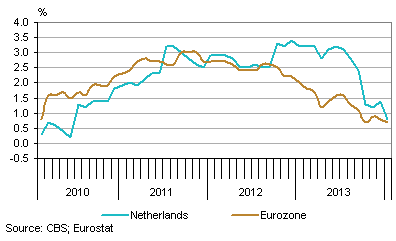Inflation down

Inflation in the Netherlands was 1.4 percent in January versus 1.7 percent in December. Dutch inflation has slowed down considerably after a 3.1 peak in July 2013. In January, the lowest level in three and a half years was reached. Inflation is defined as the increase in the consumer price index (CPI) in a particular month compared to the same month in the previous year.
The decrease in January compared to December was partly due to tax measures. In January 2013, the insurance tax rate was raised. This had an upward effect on inflation in 2013, but the effects have worn off in 2014. Electricity prices also had a downward effect on inflation.
Dutch inflation rate

The harmonised consumer price index (HICP) allows comparison between the inflation rates in the various member states of the European Union (EU). The level of inflation in the eurozone is one of the main guidelines for the European Central Bank (ECB) to change or refrain from changing the interest rate. According to the ECB, prices in the eurozone are stable, if the inflation rate is close to 2 percent.
According to the HICP method, inflation in the Netherlands fell from 1.4 percent in December to 0.8 percent in January. Eurostat, the European statistical office, calculated an inflation rate for the eurozone of 0.7 percent. Since October 2012, the Netherlands has ranked among the countries with the highest inflation rate in the eurozone. This was largely due to tax measures. As most effects of the tax measures have worn off by now, the gap between the eurozone rate and the Dutch rate has closed.
Dutch inflation according to HICP

More figures can be found in the Business cycle dossier.
For more information on economic indicators, see the Economic Monitor.